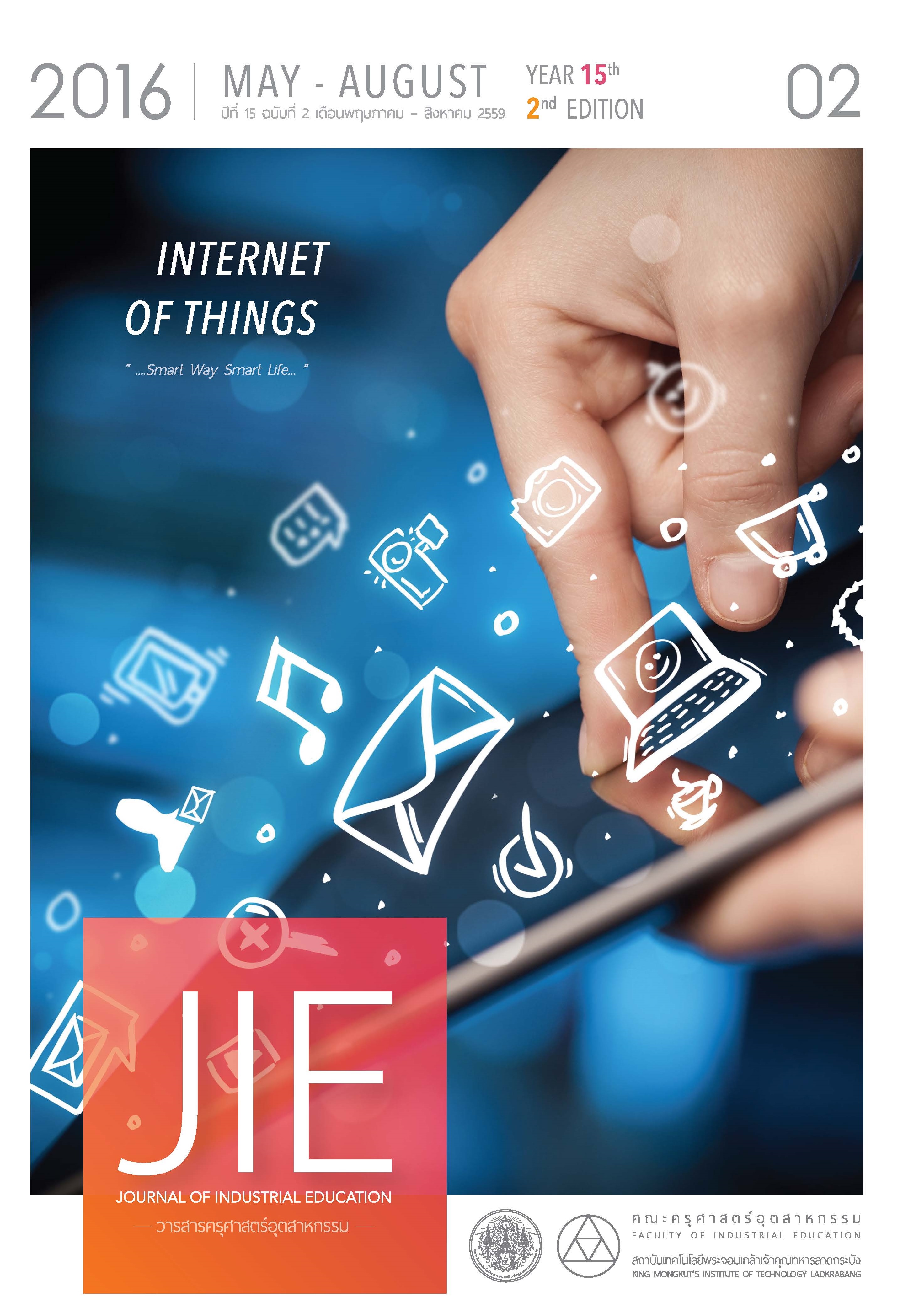A DEVELOPMENT OF WEB-BASED INSTRUCTION VIA STEM EDUCATION ACTIVITIES ON PROGRAM APPLICATION FOR GRADE 9 STUDENTS
Keywords:
Web-Based Instruction, STEM Education, Quality Evaluation, Efficiency, Learning AchievementAbstract
The main purposes of this research include developing the quality and efficiency of web-based instruction about an application development for 9th grade students via STEM education activities as well as comparing the learning achievement between the students who are learning through web-based instruction via STEM education activities and regularly-instructed group. The samples of the study are 30 students per group in second semester of academic year of 2015 from Thepha School, Songkla. Group 1 is the group of students who are learning through web-based instruction via STEM education activities and group 2 is the group of students who apply the normal learning. All samples are selected by Cluster Random Sampling Method. The research tools are comprised of web-based instruction lessons, quality evaluation questionnaire of web-based instruction and achievement test. The Index of Consistency (IOC) was reported between 0.67-1.00 while the level of difficulty was between 0.27-0.80. The degree of discrimination was between 0.20-0.53 while the test reliability was at 0.82. The data were statistically analyzed by using mean, standard deviation and independent sample t-test.
The results showed that the total quality of web-based instruction via STEM education activities was at very good level ( = 4.54, S = 0.54) with the quality of content at very good level (
= 4.58, S = 0.58) and the quality of media production at good level (
= 4.48, S = 0.50). It is also found that the efficiency of web-based instruction lessons (E1/E2) was 82.60/80.15. Furthermore, it is revealed that the learning efficiency of the student learning through web-based instruction via STEM education activities was significantly better than those of the regularly-instructed group at significant level of 0.05.
References
[2] ทวีศักดิ์ กออนันตกูล. 2545. นโยบาย e-Education. กรุงเทพฯ: ศูนย์เทคโนโลยีอิเล็กทรอนิกส์และคอมพิวเตอร์แห่งชาติ.
[3] ถนอมพร เลาหจรัสแสง. 2544. การสอนบนเว็บ (Web-Based Instruction) นวัตกรรมเพื่อคุณภาพการเรียนการสอน. วารสาร ศึกษาศาสตร์สาร. 28(1) น. 87-94.
[4] อภิสิทธิ์ ธงไชย และคณะ. 2555. สรุปการบรรยายพิเศษ เรื่อง Science, Technology, Engineering and Mathematics Education : Preparing students for the 21st Century. ค้นเมื่อวันที่ 5 มีนาคม 2557, จาก https://designtechnology.ipst.ac.th/uploads/STEMeducation.pdf
[5] ฝ่ายวิชาการโรงเรียนเทพา. 2557. ผลสัมฤทธิ์ทางการเรียนวิชาเทคโนโลยีสารสนเทศ.[ออนไลน์]. เข้าถึงได้จาก: https://www.thepha.ac.th. (วันที่ค้นข้อมูล: 5 มีนาคม 2557).
[6] อภิสิทธิ์ ธงไชย. 2556. เทคโนโลยีและวิศวกรรมคืออะไรในสะเต็มศึกษา. สถาบันส่งเสริมการสอนวิทยาศาสตร์และ เทคโนโลยี (สสวท.), 42(185), น.35-37.
[7] Seel, B. B. and Richey, R. C. 1994. Instructional Technology: The Definition and Domains of the field. Washington, D.C.: Association for Educational Communications and Technology.
[8] วรนุช ตุนทกิจ. 2553. การตรวจสอบแผนการจัดการเรียนรู้. ค้นเมื่อวันที่ 5 มีนาคม 2557, จาก https://www.km.skn.go.th/? name=research&file=readresearch&id=5
[9] ไพโรจน์ ตีรณธนากุล ไพบูลย์ เกียรติโกมลและเสกสรร แย้มพินิจ. 2546. การออกแบบและการผลิตบทเรียนคอมพิวเตอร์การ สอน. กรุงเทพฯ:ศูนย์สื่อเสริมกรุงเทพฯ.
[10] ชัยยงค์ พรหมวงศ์. และคณะ. 2542.ระบบสื่อสารการสอน. กรุงเทพฯ: โรงพิมพ์จุฬาลงกรณ์มหาวิทยาลัย.
[11] Bloom, B.S. 1956. Taxonomy of Educationalobjectives. New York: Longman.
[12] มนต์ชัย เทียนทอง. 2548. การออกแบบและพัฒนาคอร์สแวร์สำหรับบทเรียนคอมพิวเตอร์ช่วยสอน. กรุงเทพฯ: ศูนย์ผลิตตำรา เรียนสถาบันเทคโนโลยีพระจอมเกล้าพระนครเหนือ.
[13] จิรภาภรณ์ วงศ์กาญจนฉัตร. 2557. บทเรียนผ่านเครือข่ายอินเทอร์เน็ต เรื่องพระราชบัญญัติว่าด้วยการกระทำความผิดเกี่ยวกับ คอมพิวเตอร์ พ.ศ. 2550 สำหรับนักเรียนระดับประกาศนียบัตรวิชาชีพ. วิทยานิพนธ์วิทยาศาสตรมหาบัณฑิตสาขาวิชาการ ศึกษาวิทยาศาสตร์ (คอมพิวเตอร์) คณะครุศาสตร์อุตสาหกรรม สถาบันเทคโนโลยีพระจอมเกล้าคุณทหารลาดกระบัง.
Wongkanjanachut, J. 2014. Web-based Instruction on Act on computer-Related Offences be 2550. Thesis in Science, Science Education (Computer), Industrial Education, King Mongkut’s Institute of Technology Ladkrabang.
[14] จีรนันท์ ปัญญาเหลือ ฉันทนา วิริยเวชกุล และอรรถพร ฤทธิเกิด. 2558. บทเรียนบนเครือข่ายอินเทอร์เน็ต เรื่อง เรือ มอันเร.วารสารครุศาสตร์อุตสาหกรรม, 14(1), น. 191-197.
Panyalue, J., Viriyavejakul, C. and Ridhikerd, A. 2015. Web-Base Instruction Based on Reamaunre Dance. Journal of Industrial Education. 14(1), p. 191-197.
[15] Ausubel, D. P., Novak, J. D. and Hanesian, H. 1978. Educational Psychology: A Cognitive View. 2nd ed. New York:Holt, Rinehart and Winston.
[16] พลศักดิ์ แสงพรมศรี. 2558. การเปรียบเทียบผลสัมฤทธิ์ทางการเรียน ทักษะกระบวนการทางวิทยาศาสตร์ขั้นบูรณาการ และ เจตคติต่อการเรียนวิชาเคมี ของนักเรียนชั้นมัธยมศึกษาปีที่ 5 ที่ได้รับการจัดการเรียนรู้สะเต็มศึกษากับแบบปกติ.วิทยานิพนธ์ วิทยาศาสตรมหาบัณฑิต สาขาเคมีศึกษา มหาวิทยาลัยมหาสารคาม.
Saengpromsri, P. 2015. Comparisons of learning achievement, and attitude towards chemistry learning for Matthayomsueksa 5 student between STEM education and conventional methods. Thesis in Science, Chemistry Education, Mahasarakham University.
Downloads
Published
How to Cite
Issue
Section
License
"The opinions and contents including the words in papers are responsibility by the authors."
"ข้อคิดเห็น เนื้อหา รวมทั้งการใช้ภาษาในบทความถือเป็นความรับผิดชอบของผู้เขียน"



